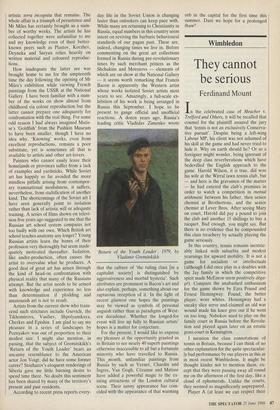Exhibitions
Russian Painting (Century Gallery, till 16 July) French Paintings from the USSR: Watteau to Matisse (National Gallery, till 18 September)
Isolating the problem
Giles Auty
With only limited access to Russian art one would prefer to form impressions rather than make judgments but I admit to wishing I liked the recent art I get to see better than I do. The principles on which many of the works are painted seem praiseworthy but are often let down by clumsiness and lack of pictorial subtlety and ambition.
The current exhibition of Russian paint- ings at Century Gallery (100 Fulham Road, SW3) is the creation of Roy Miles who has has got together over 100 works by some 40 artists. The complications and tribulations behind such an effort to cross trade fron- tiers are considerable. Mr Miles believes he is introducing us to some of the last artistic terra incognita that remains. The whole affair is a triumph of persistence and Mr Miles has certainly brought us a num- ber of worthy works. The artists he has collected together were unfamiliar to me and my knowledge even of their better- known peers such as Plastov, Korzhev, Deyneka and Saryan relies heavily on written material and coloured reproduc- tions.
How inadequate the latter are was brought home to me for the umpteenth time the day following the opening of Mr Miles's exhibition while viewing French paintings from the USSR at the National Gallery. I have been familiar with a num- ber of the works on show almost from childhood via colour reproduction but the latter cannot prepare one adequately for confrontation with the real thing. For some odd reason I had always imagined Matis- se's 'Goldfish' from the Pushkin Museum to have been smaller, though I have no idea why. 'Knowing' works, even from excellent reproductions, remains a poor substitute, yet is sometimes all that is available to artists and other art-lovers.
Painters who cannot easily leave their homelands or provinces suffer from a lack of examples and yardsticks. While Soviet art has happily so far avoided the more mindless pitfalls arising from contempor- ary transnational modishness, it suffers, nevertheless, from stultification of another kind. The shortcomings of the Soviet art I have seen generally point to isolation rather than lack of artistic will or adequate training. A series of films shown on televi- sion five years ago suggested to me that the Russian art school system compares not too badly with our own. Which British art school teaches anatomy any longer? Young Russian artists learn the bones of their profession very thoroughly but seem inade- quately motivated thereafter. Isolation, like under-production, often causes the artist to overvalue what he produces. A good deal of great art has arisen through the kind of head-on confrontation with physical reality that many of the Russians attempt. But the artist needs to be armed with knowledge and experience no less than determination if plodding and amateurish art is not to result.
Artists from the current show who trans- cend such strictures include Gurvich, the Tikhomirovs, Vasiliev, Shpolyanskaya, Cherkes and Epishin. I am glad to say my pleasure in a series of landscapes by Poznyakov was out of proportion to their modest size. I might also mention, in passing, that the subject of Gremitskikh's 'Return of the Youth Leader' bears an uncanny resemblance to the American actor Jon Voigt; did he have some former career? Stozharov's eloquent renderings of Siberia gave me little burning desire to spend time there. No doubt this sentiment has been shared by many of the territory's present and past residents.
According to recent press reports every- day life in the Soviet Union is changing faster than onlookers can keep pace with. While many are returning to Christianity in Russia, equal numbers in this country seem intent on reviving the barbaric behavioural standards of our pagan past. These are, indeed, changing times we live in. Before commenting on the great art collections formed in Russia during pre-revolutionary times by such merchant princes as the Shchukins and Morozovs — elements of which are on show at the National Gallery — it seems worth remarking that Francis Bacon is apparently the Western artist whose works isolated Soviet artists most yearn to see. Amazingly, a full-scale ex- hibition of his work is being arranged in Russia this September. I hope to be present to gauge official and unofficial reactions. A dozen years ago, Russia's leading critic Vladislav Zimenko wrote 'Return of the Youth Leader', 1979, by Vladimir Gremitskikh that the culture of 'the ruling class [in a capitalist society] is distinguished by aggressiveness and morbid hysteria'. Such attributes are prominent in Bacon's art and also explain, perhaps, something about our rapturous reception of it. In the light of recent glasnost one hopes the paintings may be viewed as symbols of personal anguish rather than as paradigms of West- ern decadence. Whether the longed-for event will live up fully to Russian artists' hopes is a matter for conjecture.
For the present, I would like to express my 'pleasure at the opportunity granted us in Britain to see nearly 40 superb paintings otherwise inaccessible to all but a fortunate minority who have travelled to Russia. This emonth, unfamiliar paintings from Russia by such as Vernet, Chardin and Ingres, Van Gogh, Cezanne and Matisse have added a powerful magic to the ex- isting attractions of the London cultural scene. Their sunny appearance has coin- cided with the appearance of that warming orb in the capital for the first time this summer. Dare we hope for a prolonged thaw?











































































 Previous page
Previous page